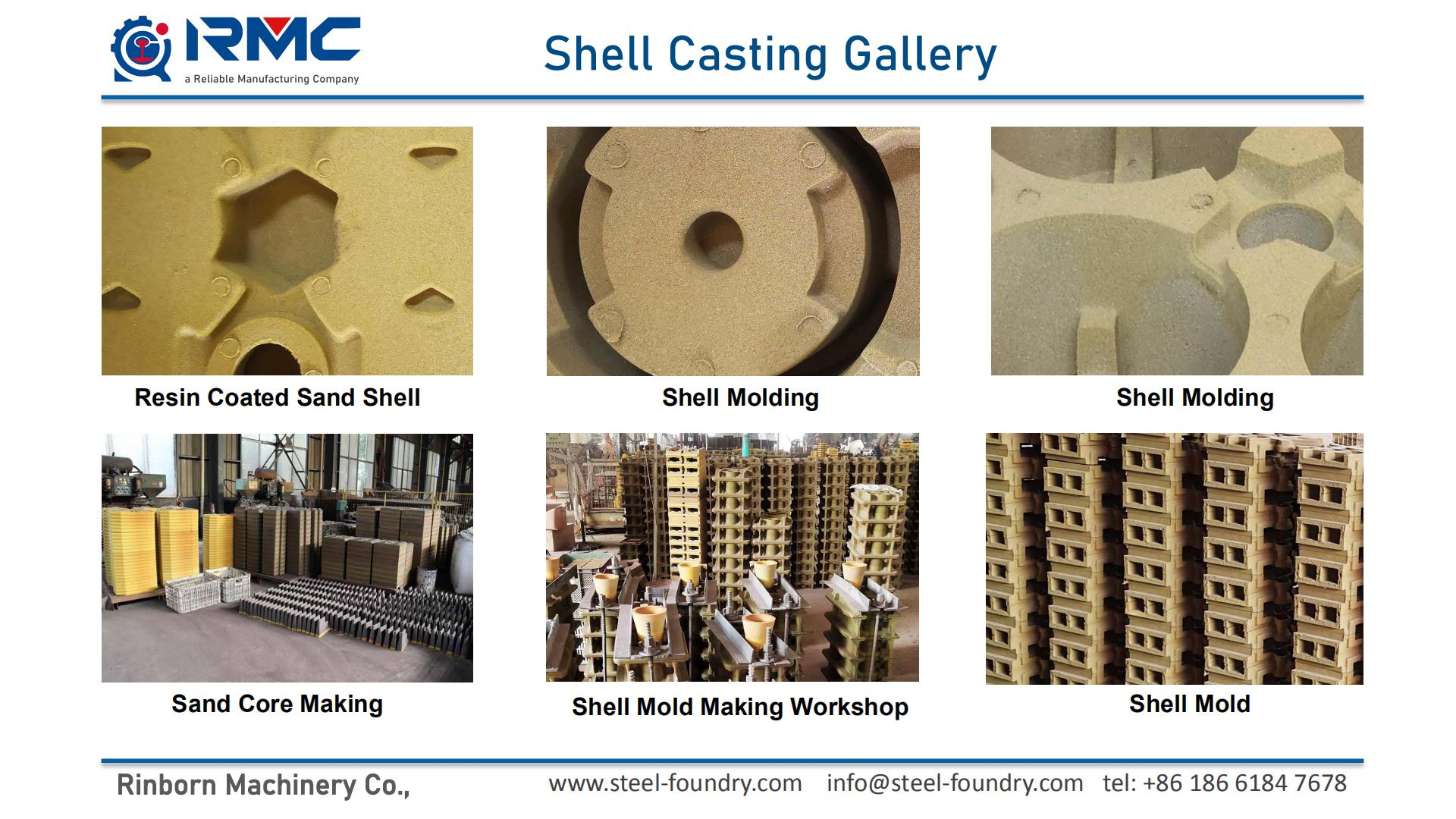China OEM custom cast carbon steel shell mold casting products.
Shell molding casting process is also called pre-coated resin sand casting process, hot shell molding castings or core casting process. The main molding material is the pre-coated phenolic resin sand, which is more expensive than green sand and furan resin sand. Moreover, this sand can not be recycle used.
Furan resin self-hardening sand casting process (nobake process) uses the furan resin coated sand to form the casting mold. After mixing the original sand (or reclaimed sand), liquid furan resin and liquid catalyst evenly, and filling them into the core box (or sand box), and then tighten it to harden into a mold or mold in the core box (or sand box) at room temperature. Then the casting mould or casting core were formed, which is called self-hardening cold-core box molding (core), or self-hardening method (core).
Because the mold is formed at room temperature and no need to heat, the self-hardening sand casting is also called no-bake casting process. The self-hardening method can be divided into acid-catalyzed furan resin and phenolic resin sand self-hardening method, urethane resin sand self-hardening method and phenolic monoester self-hardening method.
| Casting Capabilities at RMC Foundry | ||||||
| Casting Process | Annual Capacity / Tons | Main Materials | Casting Weight | Dimensional Tolerance Grade (ISO 8062) | Heat Treatment | |
| Green Sand Casting | 6000 | Gray Cast Iron, Ductile Cast Iron, Cast Al, Brass, Cast Steel, Stainless Steel | 0.3 kg to 200 kg | CT11~CT14 | Normalization, Quenching, Tempering, Annealing, Carburization | |
| Resin Coated Sand Casting (Shell Casting) | 0.66 lbs to 440 lbs | CT8~CT12 | ||||
| Lost Wax Investment Casting | Water Glass Casting | 3000 | Stainless Steel, Carbon Steel, Alloy Steel, Brass, Aluminium, Duplex Stainless Steel, Cast Iron | 0.1 kg to 50 kg | CT5~CT9 | |
| 0.22 lbs to 110 lbs | ||||||
| Silica Sol Casting | 1000 | 0.05 kg to 50 kg | CT4~CT6 | |||
| 0.11 lbs to 110 lbs | ||||||
| Lost Foam Casting | 4000 | Gray Iron, Ductile Iron, Alloy, Carbon Steel, Stainless Steel, Brass, Al | 10 kg to 300 kg | CT8~CT12 | ||
| 22 lbs to 660 lbs | ||||||
| Vacuum Casting | 3000 | Gray Iron, Ductile Iron, Alloy Steel, Carbon Steel, Stainless Steel | 10 kg to 300 kg | CT8~CT12 | ||
| 22 lbs to 660 lbs | ||||||
| High Pressure Die Casting | 500 | Aluminium Alloys, Zinc Alloys | 0.1 kg to 50 kg | CT4~CT7 | ||
| 0.22 lbs to 110 lbs | ||||||
As a self-hardening cold box binder sand, furan resin sand is the earliest and currently most widely used synthetic binder sand in Chinese foundry. The amount of resin added in molding sand is generally 0.7% to 1.0%, and the amount of added resin in core sand is generally 0.9% to 1.1%. The content of free aldehyde in furan resin is below 0.3%, and some factories have dropped to below 0.1%. In the foundries in China, the furan resin self-hardening sand has reached the international level regardless of the production process and the surface quality of the castings.
|
Resin Coated Sand Casting Metal and Alloys
|
|
| Metal & Alloys | Popular Grade |
| Gray Cast Iron | GG10~GG40; GJL-100 ~ GJL-350; |
| Ductile (Nodular) Cast Iron | GGG40 ~ GGG80; GJS-400-18, GJS-40-15, GJS-450-10, GJS-500-7, GJS-600-3, GJS-700-2, GJS-800-2 |
| Austempered Ductile Iron (ADI) | EN-GJS-800-8, EN-GJS-1000-5, EN-GJS-1200-2 |
| Carbon Steel | C20, C25, C30, C45 |
| Alloy Steel | 20Mn, 45Mn, ZG20Cr, 40Cr, 20Mn5, 16CrMo4, 42CrMo, 40CrV, 20CrNiMo, GCr15, 9Mn2V |
| Stainless Steel | Ferritic Stainless Steel, Martensitic Stainless Steel, Austenitic Stainless Steel, Precipitation Hardening Stainless Steel, Duplex Stainless Steel |
| Aluminium Alloys | ASTM A356, ASTM A413, ASTM A360 |
| Brass / Copper-based Alloys | C21000, C23000, C27000, C34500, C37710, C86500, C87600, C87400, C87800, C52100, C51100 |
| Standard: ASTM, SAE, AISI, GOST, DIN, EN, ISO, and GB | |
The Advantages of Furan Resin Coated Sand Self-hardening Molding Casting:
1) Improve the dimensional accuracy of castings and the surface roughness.
2) The hardening of the mold (core) sand does not require drying, which can save energy, and inexpensive wood or plastic core boxes and templates can also be used.
3) Self-hardnening molding sand is easy to compact and collapse, easy to clean up castings, and old sand can be recycled and reused, which greatly reduces the labor intensity of core making, modeling, sand falling, cleaning and other links, and it is easy to realize mechanization or automation.
4) The mass fraction of resin in sand is only 0.8%~2.0%, and the comprehensive cost of raw materials is low.
Because the self-hardening method has many of the above-mentioned unique advantages, the self-hardening method is not only used for core making, but also used for casting moulding. It is especially suitable for single piece and small batch production, and can produce cast iron, cast steel and non-ferrous alloy castings. Some Chinese foundries have completely replaced clay dry sand molds, cement sand molds, and partially replaced water glass sand molds.

Ductile Cast Iron Products












